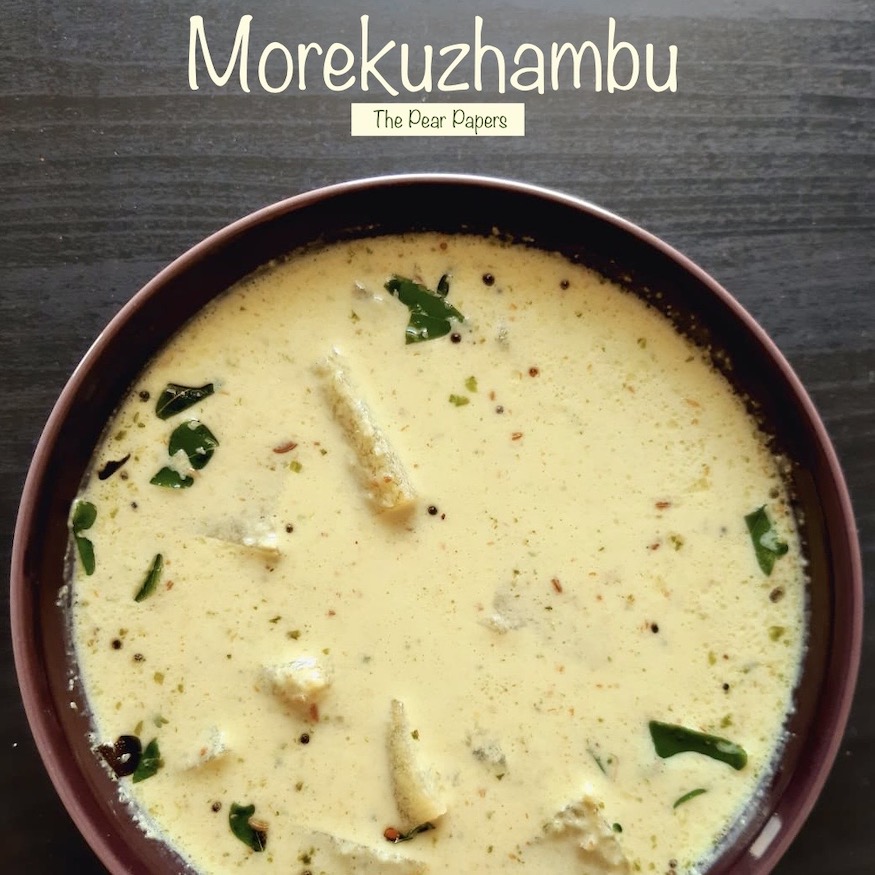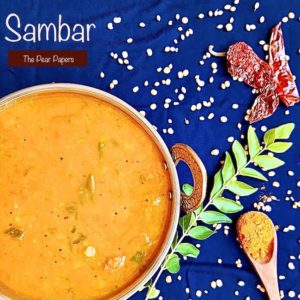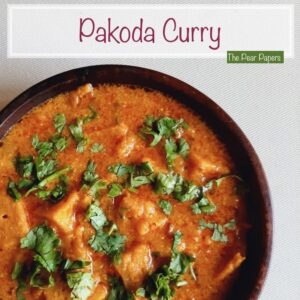
Morekuzhambu
Morekuzhambu is a traditional coconut based gravy dish made using mildly sour yoghurt and a choice of South Indian vegetable. ‘More’ in tamil means buttermilk (diluted yoghurt) and kuzhambu is something like a broth.
Morekuzhambu is very important in our wedding lunch menu and almost all other functions and festivals. This is mildly sour and spicy, with the richness of coconut and coconut oil. This is one of the easy, quick dishes to make in literally 15 mins from prep to end. Vegetables like ash gourd, okra, brinjal, pumpkin, capsicum are normally added to morekuzhambu to make it more nutritious. Fried turkey berry, medhu vadai and bonda are few other exotic additions to make morekuzhambu more interesing. Quite often this dish is paired with a dry spicy curry like okra, potato, yam or sweet potato. But for an authentic south Indian experience pair morekuzhambu with either french beans or cluster beans paruppu usili or go for a simple dry brinjal curry with brinjal podi.
Here’s my recipe for a simple tasty morekuzhambu. Serve with hot steamed rice and curry of your choice.
Ingredients
Ash gourd (peeled and cut into chunks) – 2 cups (see note 1 for alternate vegetables to use)
Turmeric powder – 1/2 tsp
Salt – 1 tsp (or to taste)
Sour yoghurt – 2 cups
Water – 2 cups
Brown sugar – 1/2 tsp
Coconut oil – 2 tbsp
Fresh coconut (grated) – 4 tbsp
Green chillies – 6 (or to taste)
Coriander seeds – 1 tsp
Cumin seeds – 2 tsp
Ginger (grated) – 1 tbsp
Fresh coriander leaves (roughly chopped) – 3 tbsp
Mustard seeds – 1 tsp
Fenugreek seeds – 1/2 tsp
Fresh curry leaves – a few leaves
Yield
Serves 5
Prep time
10 mins
Cook time
15 mins
Method
1) In a pan take the cut ash gourd chunks. Add 1/4 tsp turmeric powder and 1/4 tsp salt. Add just enough water to cover the ash gourd and keep on medium heat until it is fully cooked. Set aside.
2) Take sour yoghurt, add 2 cups of water, sugar, 3/4 tsp salt and 1 tbsp coconut oil. Blend everything well with a whisk. Set aside.
3) In a mixer take fresh grated coconut, chillies, coriander seeds, cumin seeds, coriander leaves and ginger. Grind these to a coarse paste with just a tbsp of water. Add this ground mixture to the diluted yoghurt, mix and set aside.
4) Heat a tempering pan and add a tbsp of coconut oil. Add mustard seeds and let it splutter. Now add fenugreek seeds and fry until golden. Then add curry leaves, mix and transfer to the yoghurt-coconut mixture. Add the cooked ash gourd also to this tempered yoghurt mixture and mix well.
5) Now heat this tempered yoghurt mixture on minimum heat for just 2 to 3 mins. Your tasty morekuzhambu is ready to serve.
Notes
- I’ve used ash gourd to make this morekuzhambu. Ash gourd being a watery vegetable, I’ve boiled it with salt and added to the kuzhambu. Alternatively you can use shallow fried okra, brinjal, pumpkin or capsicum. Use enough coconut oil and salt to shallow fry any of the above vegetables until well cooked. Particularly if you are using okra or brinjal, fry until the vegetable turns crisp. Then add this to the diluted yoghurt and continue with the other steps.
- I get sour yoghurt in the supermarkets and I use that to make this dish. If you don’t get sour yoghurt easily, then keep fresh yoghurt in a warm place for a day (to make it sour) and then use. The tanginess from sour yoghurt is important and adds an extra taste to this dish.
- The highlight of this dish is fresh coconut and coconut oil. So I suggest to use only fresh coconut and good quality coconut oil to make morekuzhambu and enjoy its authentic taste.
- Generally coriander leaves is not used in this dish. But I love the flavour and colour it adds, so I use it. You can choose to either add or omit this totally. It’s up to you.
- Refrigerate leftover kuzhambu and use it for up to 2 days.
Beginner’s tips
- Make sure to just warm the morekuzhambu after adding all the ingredients. Don’t bring it to boil as yoghurt tends to curdle when heated.


You May Also Like

Sambar
August 15, 2021
Pakoda Curry
October 8, 2023